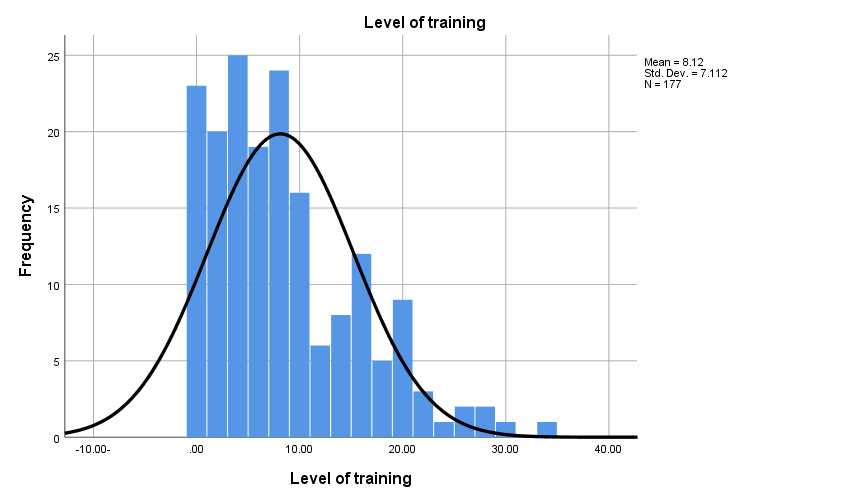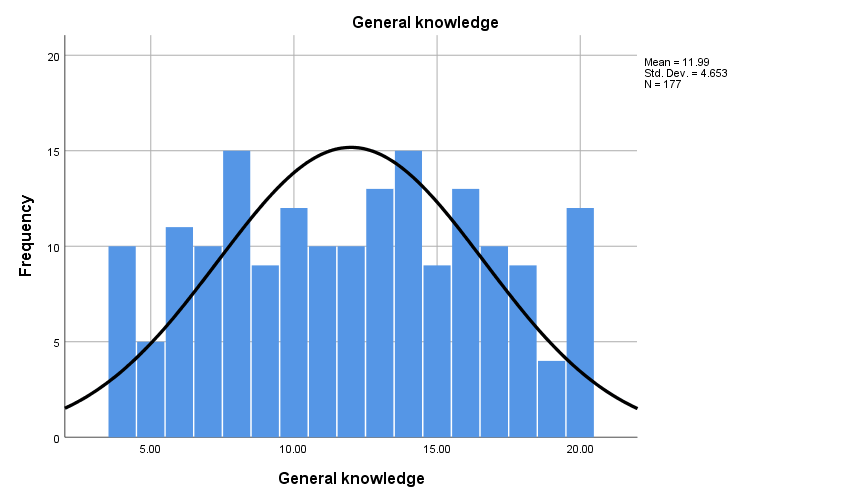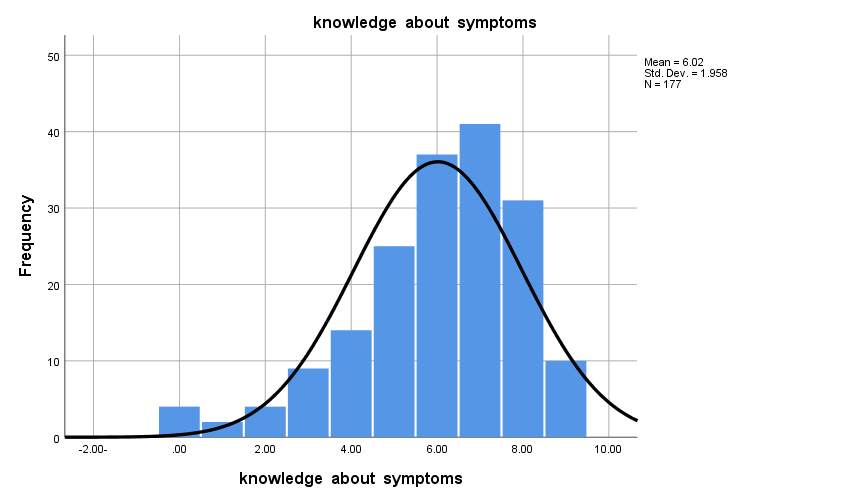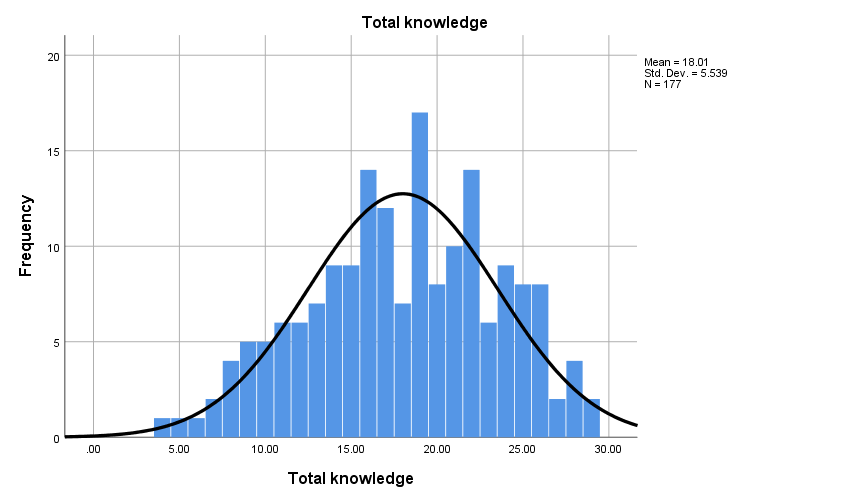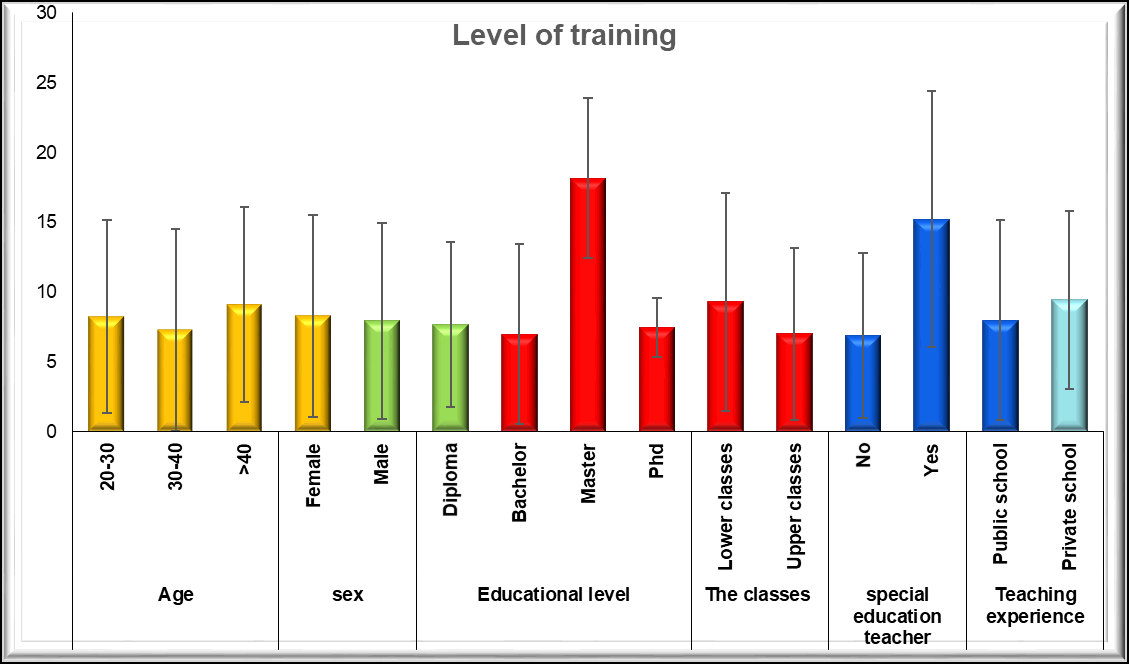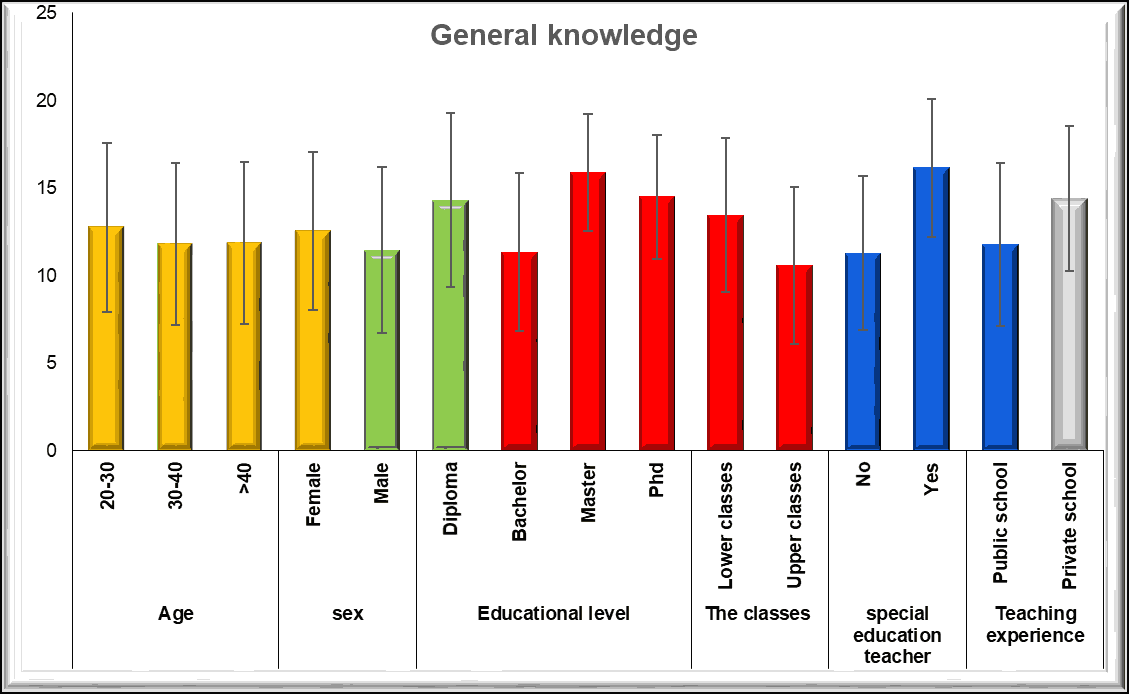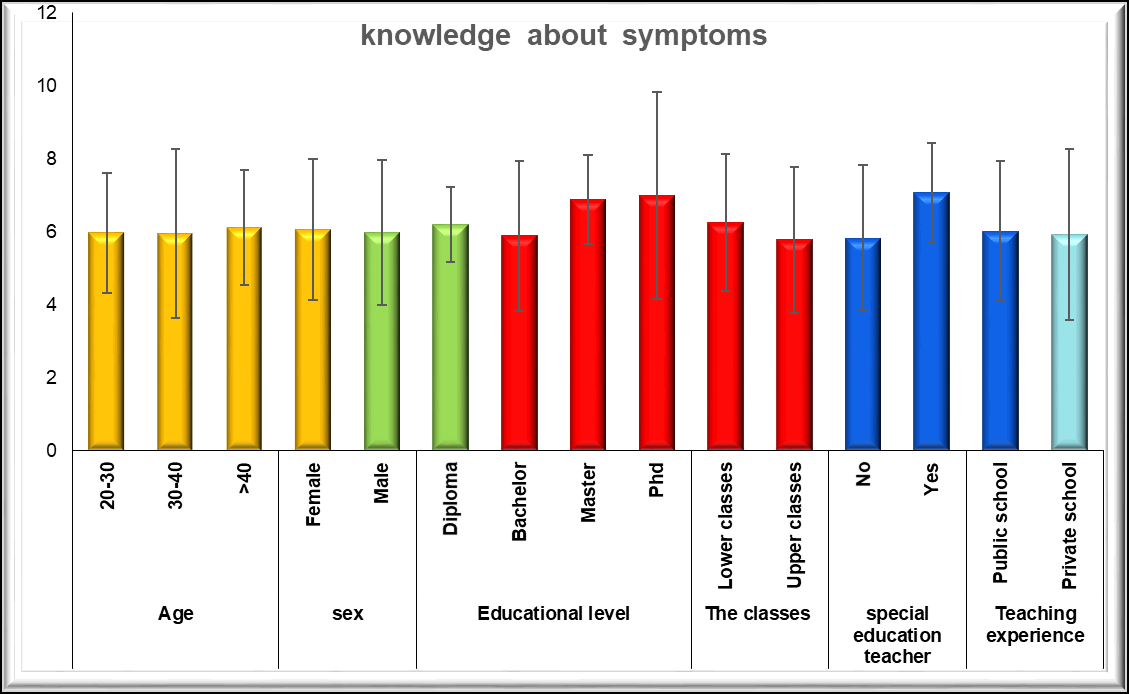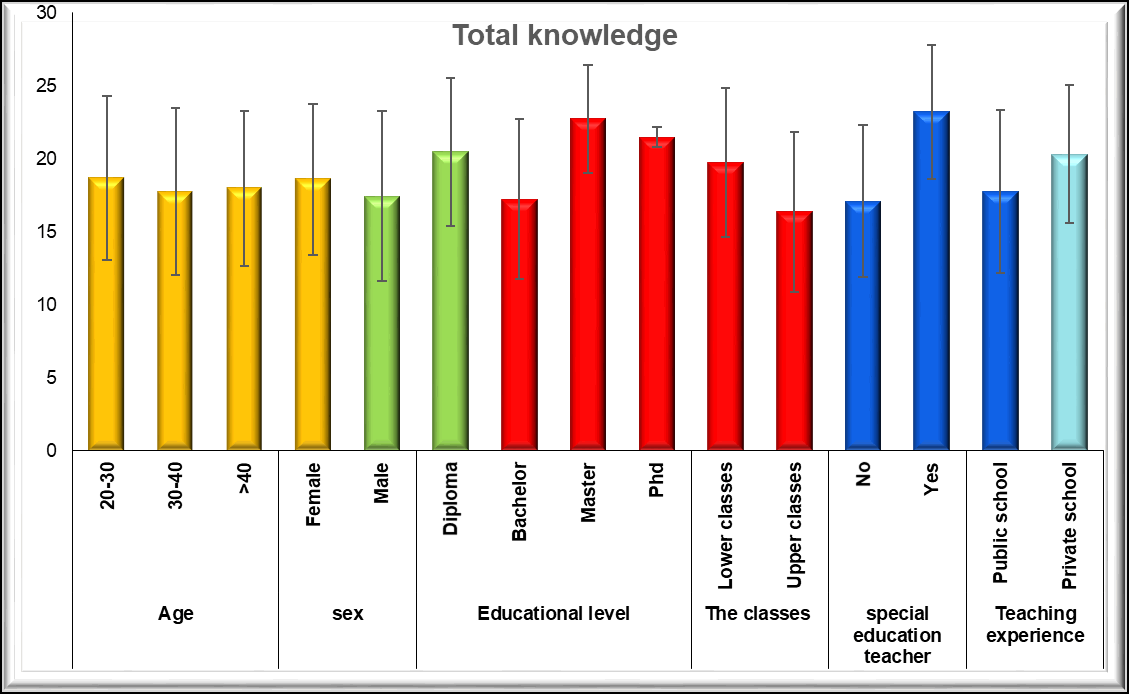Research Article - Current Pediatric Research (2022) Volume 26, Issue 1
Primary school teacher's awareness and knowledge of dyslexia in Qassim region-Saudi Arabia.
Alharbi Hatim Yousef*
Department of Psychiatry, College of Medicine, Qassim University, Buraydah, Saudi Arabia
- Corresponding Author:
- Alharbi Hatim Yousef
Department of Psychiatry, College of Medicine, Qassim University, Buraydah, Saudi Arabia
E-mail: Hy.alharbi@qu.edu.sa
Received: 06 January, 2022, Manuscript No. AAJCP-22-51313; Editor assigned: 07 January, 2022, PreQC No. AAJCP-22-51313(PQ); Reviewed: 13 January, 2022, QC No. AAJCP-22-51313; Revised: 23 January, 2022, Manuscript No. AAJCP-22-51313(R);Published: 31 January, 2022, DOI:10.35841/0971-9032.26.1.1220-1230.
Abstract
Dyslexia represents a major educational and medical issue. Students with dyslexia can go through multiple psychological and emotional problems such as depression and anxiety. Primary school teachers could play a crucial role in identifying dyslexia early and creating awareness about learning disorders in the community. However, there are very few studies on the knowledge of primary school teachers about dyslexia. This study aims to assess the knowledge and awareness of dyslexia in primary school teachers in Qassim region Saudi Arabia and to assess the variables influencing the knowledge. Therefore 172, teachers from different primary schools in the Qassim region were given a self-report questionnaire, socio-demographic history was elicited, and the teacher’s preparation and knowledge were assessed based on their responses to the questionnaire. The results showed that most teachers lack the training, knowledge, and skills to diagnose dyslexic students in their classrooms. Furthermore, the higher levels of knowledge and awareness were significantly correlated with higher educational level, being a teacher for the lower classes, and working as a special education teacher. The findings of this article carry the notion that the lack of knowledge and awareness among school teachers regarding the term dyslexia puts the affected students at significant difficulties.
Keywords
Learning disorder, Dyslexia, Primary school, Teachers.
Introduction
According to the international dyslexia association, dyslexia can be defined as a specific learning disability that is neurobiological in origin. It is characterized by difficulties with accurate and/or fluent word recognition and poor spelling and decoding abilities. These difficulties typically result from a deficit in the phonological component of language that is often unexpected with other cognitive abilities and the provision of effective classroom instruction. Secondary consequences may include problems in reading comprehension and reduced reading experience that can impede the growth of vocabulary and background knowledge [1]. A study conducted in Saudi about the prevalence of learning difficulties found that dyslexia was the most common learning difficulty representing almost 31.4% [2]. However, this high prevalence of dyslexia has not received adequate attention in Saudi Arabia. In addition, untreated or poorly recognized dyslexia can make the student feel frustrated and affect his self-confidence and self-esteem [3].
Furthermore, these children can go through multiple psychological and emotional problems, depression, and anxiety [4]. Students with dyslexia are shown to have multiple somatic complaints like headaches and stomachaches in response to academic demands [5]. Early identification and management of every disability help to improve it. It is worth mentioning that teachers' awareness about dyslexia is critical in identifying dyslexic students [6]. Unfortunately, many teachers ignored dyslexic students and even called them "lazy" and "stupid." This perception indicated that the teacher awareness about dyslexia is not optimum. This lack of awareness means that the intervention is delayed or even not happened at all. A study conducted on Saudi female teachers found that 58.33% are not qualified to identify and deal with dyslexic students [2].
Therefore, this study aimed to investigate Saudi teachers' knowledge and awareness of dyslexia in the primary schools in Qassim region Saudi Arabia. This research is targeted to benefit the students in getting more help and support by raising their teacher awareness about dyslexia. It is also expected to benefit policy makers by basing their actions on valid data. Furthermore, it is expected that the findings of this research will contribute to the body of knowledge related to teacher awareness of dyslexic students because it is the first study in Saudi examining male and female primary school teachers' knowledge and awareness level of dyslexia.
Statement of the problem
Awareness about dyslexia is an essential aspect for all teachers. Teachers can play a significant role in educating and supporting the student with dyslexia. They can help their dyslexic students to overcome their reading and spelling problems only if they have a good knowledge and awareness about dyslexia. This research attempts to investigate the knowledge and awareness of the primary school teacher working in different schools of Qassim region, Saudi Arabia.
Methodology
Research hypotheses
H1: Primary school's teachers in Qassim, Saudi Arabia, are trained to deal with students with dyslexia.
H2: Primary school's teachers in Qassim, Saudi Arabia, have adequate knowledge and awareness about the early signs of dyslexia.
H3: There are mean differences between teachers' training, knowledge, and awareness levels and their ability to diagnose symptoms of dyslexia, compared with their demographic background (gender, educational degree, and teaching experience).
Research design
An observational cross-sectional study conducted in October 2021.
Study area
Public and private primary schools in Qassim, Saudi Arabia. From 1st grade to 6th grade teachers.
Research instrument
The data was collected through a self-reported questionnaire. Amel Aladwani and her colleagues developed the questionnaire in their study "primary school teacher’s awareness and knowledge of dyslexia in Kuwaiti students". The questionnaire showed to be valid and reliable. It consists of the following parts:
•Independent variables include demographic data such as teachers' gender, age, level of education, and years of experience.
•Dependent variables: There are three dependent variables: Teacher preparation: examined the level of preparation teachers have in dealing with dyslexic students and learning difficulties, which includes 11 items. Two items were not practically applicable to Qassim region. They were related to workshops conducted by the Kuwait dyslexia association and the Kuwait child evaluation center in "Alsurra" area. So, these two items were deleted.
•Teacher knowledge and awareness: Examined the degree of knowledge and awareness teachers have about dyslexia, which includes 4 items; and
•Teacher diagnosis: Examine the teacher's ability to diagnose and discover the symptoms of dyslexic students, which includes 10 items.
Data collection
Since the COVID-19 pandemic affected the learning process in Saudi, all schools went through distance learning. This situation makes in-person interviewing of teachers is not feasible. Hence, the questionnaire was sent to the primary school teachers through different social media platforms such as Email, WhatsApp, and Twitter.
Data analysis
The data were tabulated using SPSS statistic software. Then, two data analysis procedures were conducted. The first is descriptive statistics, which include percentages, frequencies, and means. This data was used to describe the primary response to the questionnaire. The second is ANOVA test (using one way ANOVA) to compare the study variables' means and significant levels.
Results
Table 1 shows the demographics of included subjects. The majority of subjects 46.3% were aged 30 to 40 years old, followed by 37.3% older than 40 and 16.4% from 20-30 years old. A percent of 48% were females, and 52% were males. Most of the participants, 83.6%, had a bachelor's degree representing the majority of subjects. More than half of them teach upper classes, and 48.6% teach lower classes. Only 14.7% of them are special education teachers. As for the teaching experience, 26.6% had 5-10 years of experience, followed by 20.3% who had 10-15 years of experience, 14% had 15-20 years' experience, and 13.6% had 1-5 years' experience. Most of the teachers work at public schools 91.5%.
| N | % | ||
|---|---|---|---|
| Age | 20-30 | 29 | 16.4 |
| 30-40 | 82 | 46.3 | |
| >40 | 66 | 37.3 | |
| Sex | Female | 85 | 48 |
| Male | 92 | 52 | |
| Educational level | Diploma | 10 | 5.6 |
| Bachelor | 148 | 83.6 | |
| Master | 17 | 9.6 | |
| PhD | 2 | 1.1 | |
| The classes you teach | Lower classes | 86 | 48.6 |
| Upper classes | 91 | 51.4 | |
| Are you a special education teacher? | No | 151 | 85.3 |
| Yes | 26 | 14.7 | |
| Teaching experience | <1 | 13 | 7.3 |
| 1-5 | 24 | 13.6 | |
| 5-10 | 47 | 26.6 | |
| 10-15 | 36 | 20.3 | |
| 15-20 | 25 | 14.1 | |
| 20-25 | 17 | 9.6 | |
| 25-30 | 11 | 6.2 | |
| >30 | 4 | 2.3 | |
| School type | Public school | 162 | 91.5 |
| Private school | 15 | 8.5 |
Table 1. Demographics’ and work characteristics of included subjects.
The teachers' training status and preparations were presented in Table 2 as most of the teachers have a low level of training and experience about dyslexia. The majority of respondents have never attended any workshops conducted about teaching the Arabic language 44.6%, students’ learning difficulties 52%, and dyslexia in the Ministry of Education (MOE) 72.3% or workshops about low achievers' students 61%. Also, 81.9% have never attended any Workshop about dyslexia in any Centers outside Qassim. As for the knowledge about dyslexia, 44.1% have never read books about dyslexia, and 37.3% have researched dyslexia from the World Wide Web. Only 38% of teachers have dealt with students with dyslexia in the past (Table 2).
| Data | % Training | Chi-square | ||||||||
|---|---|---|---|---|---|---|---|---|---|---|
| Never | Once | Twice | Thrice | Four and more | X2 | P-value | ||||
| 1 | Have you attended any workshops about teaching the Arabic language? | N |
79 | 36 | 19 | 13 | 30 | 33 | 76.305 | <0.001* |
% |
44.60% | 20.30% | 10.70% | 7.30% | 16.90% | |||||
| 2 | Have you attended any workshops about students learning difficulties? | N |
92 | 45 | 16 | 13 | 11 | 23 | 134.723 | <0.001* |
% |
52.00% | 25.40% | 9.00% | 7.30% | 6.20% | |||||
| 3 | Have you attended any workshop conducted by the Learning Disabilities Society? | N |
155 | 11 | 5 | 4 | 2 | 6 | 506.362 | <0.001* |
% |
87.60% | 6.20% | 2.80% | 2.30% | 1.10% | |||||
| 4 | Have you attended any workshops conducted about dyslexia in the Ministry of Education (MOE)? | N |
128 | 23 | 11 | 11 | 4 | 13 | 308.056 | <0.001* |
% |
72.30% | 13.00% | 6.20% | 6.20% | 2.30% | |||||
| 5 | Have you attended any workshops about low achievers students? | N |
108 | 46 | 14 | 4 | 5 | 15 | 218.96 | <0.001* |
% |
61.00% | 26.00% | 7.90% | 2.30% | 2.80% | |||||
| 6 | Have you attended any workshops about dyslexia in any Centers outside Qassim? | N |
145 | 16 | 8 | 5 | 3 | 8 | 426.927 | <0.001* |
% |
81.90% | 9.00% | 4.50% | 2.80% | 1.70% | |||||
| 7 | Have you read any books about dyslexia | N |
78 | 55 | 17 | 8 | 19 | 27 | 100.486 | <0.001* |
% |
44.10% | 31.10% | 9.60% | 4.50% | 10.70% | |||||
| 8 | Have you researched anything about dyslexia from the world wide web? | N |
66 | 37 | 18 | 10 | 46 | 41 | 56.475 | <0.001* |
% |
37.30% | 20.90% | 10.20% | 5.60% | 26.00% | |||||
| 9 | Have you dealt with any dyslexic students in the past | N |
66 | 42 | 17 | 15 | 37 | 38 | 49.073 | <0.001* |
% |
37.30% | 23.70% | 9.60% | 8.50% | 20.90% | |||||
Table 2. Distribution of teacher's training and appropriate preparation to identify dyslexic learners.
Table 3 represents the perception of teachers about their level of knowledge about dyslexia. 32.8% of teachers think that their awareness about dyslexia is weak, 22% are acceptable, and 20.95% are moderate. Only 13% and 11.3% have good and very good awareness about dyslexia. The level of knowledge about specific learning disorders was acceptable among 28.8%, moderate among 23.7%, and weak among 20.3%. The reading skills level and awareness of the dyslexic learners’ tendency to reverse the letters were good to very good among most teachers.
| Data |
%of agreement |
Chi-square |
||||||||
|---|---|---|---|---|---|---|---|---|---|---|
| Weak |
Acceptable |
Moderate |
Good |
Very good |
X2 |
P-value |
||||
| 1 | I would rate my knowledge and awareness about dyslexia | N | 58 | 39 | 37 | 23 | 20 | 50 | 25.91 | <0.001* |
| % | 32.80% | 22.00% | 20.90% | 13.00% | 11.30% | |||||
| 2 | My knowledge level in specific learning disorders | N | 36 | 51 | 42 | 27 | 21 | 54 | 15.966 | 0.003* |
| % | 20.30% | 28.80% | 23.70% | 15.30% | 11.90% | |||||
| 3 | My knowledge level to reading skills | N | 13 | 22 | 36 | 45 | 61 | 73 | 40.373 | <0.001* |
| % | 7.30% | 12.40% | 20.30% | 25.40% | 34.50% | |||||
| 4 | My awaernce to the dyslexic learner's tendency to reverse the letters | N | 31 | 32 | 38 | 33 | 43 | 63 | 2.859 | 0.582 |
| % | 17.50% | 18.10% | 21.50% | 18.60% | 24.30% | |||||
Table 3. Represent the perception of teachers about their level of knowledge about dyslexia.
The knowledge of teachers regarding symptoms and characteristics of dyslexia was presented in the Table 3. Most of the teachers have good knowledge about some symptoms and characteristics of dyslexia, including reversing the letters 73.4%, reading skills is an aspect of intelligence 66.7%, reading comprehension problems 69.5%, avoiding reading aloud 54.8%, spelling errors 66.1% and the effect of hearing or vision problems in diagnosis of dyslexia 65.5%. On the other hand, the majorities have either wrong or no knowledge about gender differences, relationship with IQ level, and low self-esteem association with dyslexia (Table 4).
| Data |
% Correction |
Chi-square |
||||||
|---|---|---|---|---|---|---|---|---|
| Wrong phrase |
I do not know |
Correct phrase |
X2 |
P-value |
||||
| 1 | Reversing the letters | N | 16 | 31 | 130 | 73% | 130.068 | <0.001* |
| % | 9.00% | 17.50% | 73.40% | |||||
| 2 | Reading skills is an aspect of intelligence | N | 40 | 19 | 118 | 67% | 92.237 | <0.001* |
| % | 22.60% | 10.70% | 66.70% | |||||
| 3 | Dyslexic students have reading comprehension problems | N | 36 | 18 | 123 | 69% | 106.881 | <0.001* |
| % | 20.30% | 10.20% | 69.50% | |||||
| 4 | Dyslexia is more common in girls than boys | N | 97 | 66 | 14 | 55% | 59.627 | <0.001* |
| % | 54.80% | 37.30% | 7.90% | |||||
| 5 | Avoid reading aloud is a symptom of dyslexia | N | 55 | 25 | 97 | 55% | 44.339 | <0.001* |
| % | 31.10% | 14.10% | 54.80% | |||||
| 6 | Dyslexic children reading unfamiliar words faster than familiar words | N | 114 | 35 | 28 | 64% | 77.322 | <0.001* |
| % | 64.40% | 19.80% | 15.80% | |||||
| 7 | Spelling errors are a symptom of dyslexia | N | 38 | 22 | 117 | 66% | 87.695 | <0.001* |
| % | 21.50% | 12.40% | 66.10% | |||||
| 8 | Dyslexia indicate low IQ | N | 108 | 38 | 31 | 61% | 61.458 | <0.001* |
| % | 61.00% | 21.50% | 17.50% | |||||
| 9 | Dyslexia does not affect the child self-esteem | N | 122 | 14 | 41 | 69% | 107.085 | <0.001* |
| % | 68.90% | 7.90% | 23.20% | |||||
| 10 | Dyslexia can be diagnosed if the difficulty in reading is only due to hearing or vision problems | N | 39 | 22 | 116 | 22% | 85.051 | <0.001* |
| % | 22.00% | 12.40% | 65.50% | |||||
Table 4. The knowledge about symptoms and characteristics.
The overall level of training was weak among most of the teachers 88.1%. The general knowledge level was weak among 33.9%, average among 33.9%, and high among 32.2%. The knowledge about symptoms and characteristics was average among more than half of the teachers. Also, the total knowledge was average among 51.4%, high among 22%, and weak among 26.6% (Table 5; Figures 1 to 4).
| Score | ||||
|---|---|---|---|---|
| N | % | Range | Mean ± SD | |
| Level of training | ||||
Weak |
156 |
88.1 |
0-34 |
8.124 ± 7.112 |
Average |
17 |
9.6 |
||
High |
4 |
2.3 |
||
General knowledge |
||||
Weak |
60 |
33.9 |
4-20 |
11.98 ± 4.652 |
Average |
60 |
33.9 |
||
High |
57 |
32.2 |
||
Knowledge about symptoms |
||||
Weak |
33 |
18.6 |
0-9 |
6.016 ± 1.952 |
Average |
103 |
58.2 |
||
High |
41 |
23.2 |
||
Total knowledge |
||||
Weak |
47 |
26.6 |
4-29 |
18.00 ± 5.532 |
Average |
91 |
51.4 |
||
High |
39 |
22 |
||
Table 5. The knowledge of teachers regarding symptoms and characteristics of dyslexia.
There was a significant positive association between a high level of training and good general knowledge. Also, higher the level of training and general knowledge, the higher the level of knowledge about the symptoms showing a significant positive correlation (Table 6).
| Correlations | |||
|---|---|---|---|
| Level of training | General knowledge | ||
| General knowledge | r | 0.62 | |
| P-value | <0.001* | ||
| Knowledge about symptoms | r | 0.316 | 0.285 |
| P-value | <0.001* | <0.001* | |
Table 6. Correlation between the levels of knowledge with training status. *: Significant showing positive correlation.
As for the relation between the knowledge and training status with the teaching experience, there was no significant correlation between teaching experience with neither level of training, general knowledge, knowledge about symptoms, nor total knowledge (Table 7).
| Teaching experience | ||
|---|---|---|
| r | P-value | |
| Level of training | 0.086 | 0.256 |
| General knowledge | -0.012 | 0.878 |
| Knowledge about symptoms | 0.057 | 0.452 |
| Total knowledge | 0.01 | 0.892 |
Table 7. Correlation between the level of knowledge and training with teaching experience.
The correlation between demographics’ variables with the level of training showed that the higher educational level and being a teacher for the lower grade were significant associative variables of the high level of training (Table 8; Figure 5).
| Demographic variables | N | Level of training | F or T | ANOVA or T-test | ||||
|---|---|---|---|---|---|---|---|---|
| Mean | ± | SD | test value | P-value | ||||
| Age | 20-30 | 29 | 8.241 | ± | 6.906 | t | 1.233 | 0.294 |
| 30-40 | 82 | 7.28 | ± | 7.237 | ||||
| >40 | 66 | 9.121 | ± | 7.015 | ||||
| Sex | Female | 85 | 8.306 | ± | 7.228 | t | 0.326 | 0.745 |
| Male | 92 | 7.957 | ± | 7.038 | ||||
| Educational level | Diploma | 10 | 7.7 | ± | 5.889 | f | 15.704 | 0 |
| Bachelor | 148 | 7.007 | ± | 6.472 | ||||
| Master | 17 | 18.176 | ± | 5.714 | ||||
| PhD | 2 | 7.5 | ± | 2.121 | ||||
| The classes | Lower classes | 86 | 9.302 | ± | 7.837 | t | 2.165 | 0.032 |
| Upper classes | 91 | 7.011 | ± | 6.19 | ||||
| Special education teacher | No | 151 | 6.901 | ± | 5.918 | t | -6.049 | 0 |
| Yes | 26 | 15.231 | ± | 9.184 | ||||
| Teaching experience | Public school | 162 | 8 | ± | 7.182 | t | -0.763 | 0.446 |
| Private school | 15 | 9.467 | ± | 6.368 | ||||
Table 8. The relationship between demographics' variables and level of training.
The higher levels of general knowledge were significantly associated with higher educational levels, being a teacher for the lower grade, working as a special education teacher, and working at private schools (Tables 9 and 10; Figures 6 and 7).
| Demographic variables | N | General knowledge | F or T | ANOVA or T-test | ||||
|---|---|---|---|---|---|---|---|---|
| Mean | ± | SD | test value | P-value | ||||
| Age | 20-30 | 29 | 12.759 | ± | 4.823 | t | 0.477 | 0.622 |
| 30-40 | 82 | 11.805 | ± | 4.631 | ||||
| >40 | 66 | 11.879 | ± | 4.643 | ||||
| Sex | Female | 85 | 12.553 | ± | 4.503 | t | 1.557 | 0.121 |
| Male | 92 | 11.467 | ± | 4.752 | ||||
| Educational level | Diploma | 10 | 14.3 | ± | 4.968 | f | 6.461 | 0 |
| Bachelor | 148 | 11.351 | ± | 4.528 | ||||
| Master | 17 | 15.882 | ± | 3.333 | ||||
| PhD | 2 | 14.5 | ± | 3.536 | ||||
| The classes | Lower classes | 86 | 13.465 | ± | 4.386 | t | 4.304 | 0 |
| Upper classes | 91 | 10.593 | ± | 4.484 | ||||
| Special education teacher | No | 151 | 11.272 | ± | 4.394 | t | -5.31 | 0 |
| Yes | 26 | 16.154 | ± | 3.926 | ||||
| Teaching experience | Public school | 162 | 11.765 | ± | 4.646 | t | -2.119 | 0.036 |
| Private school | 15 | 14.4 | ± | 4.137 | ||||
Table 9. The relationship between demographics' variables and general knowledge.
| Demographic variables | N | Knowledge about symptoms | F or T | ANOVA or T-test | ||||
|---|---|---|---|---|---|---|---|---|
| Mean | ± | SD | test value | P-value | ||||
| Age | 20-30 | 29 | 5.966 | ± | 1.636 | t | 0.148 | 0.862 |
| 30-40 | 82 | 5.951 | ± | 2.32 | ||||
| >40 | 66 | 6.121 | ± | 1.584 | ||||
| Sex | Female | 85 | 6.059 | ± | 1.936 | t | 0.273 | 0.785 |
| Male | 92 | 5.978 | ± | 1.989 | ||||
| Educational level | Diploma | 10 | 6.2 | ± | 1.033 | f | 1.518 | 0.212 |
| Bachelor | 148 | 5.892 | ± | 2.048 | ||||
| Master | 17 | 6.882 | ± | 1.219 | ||||
| PhD | 2 | 7 | ± | 2.828 | ||||
| The classes | Lower classes | 86 | 6.267 | ± | 1.881 | t | 1.663 | 0.098 |
| Upper classes | 91 | 5.78 | ± | 2.01 | ||||
| Special education teacher | No | 151 | 5.834 | ± | 1.991 | t | -3.058 | 0.003 |
| Yes | 26 | 7.077 | ± | 1.354 | ||||
| Teaching experience | Public school | 162 | 6.025 | ± | 1.927 | t | 0.172 | 0.863 |
| Private school | 15 | 5.933 | ± | 2.344 | ||||
Table 10. The relationship between demographics' variables and knowledge about the symptoms.
The higher levels of total knowledge were significantly correlated with higher educational level, being a teacher for the lower classes, and working as a special education teacher (Table 11; Figure 8).
| Demographic variables | N | Total knowledge | F or T | ANOVA or T-test | ||||
|---|---|---|---|---|---|---|---|---|
| Mean | ± | SD | test value | P-value | ||||
| Age | 20-30 | 29 | 18.724 | ± | 5.618 | t | 0.325 | 0.723 |
| 30-40 | 82 | 17.756 | ± | 5.734 | ||||
| >40 | 66 | 18 | ± | 5.309 | ||||
| Sex | Female | 85 | 18.612 | ± | 5.183 | t | 1.403 | 0.162 |
| Male | 92 | 17.446 | ± | 5.82 | ||||
| Educational level | Diploma | 10 | 20.5 | ± | 5.061 | f | 6.643 | 0 |
| Bachelor | 148 | 17.243 | ± | 5.466 | ||||
| Master | 17 | 22.765 | ± | 3.7 | ||||
| PhD | 2 | 21.5 | ± | 0.707 | ||||
| The classes | Lower classes | 86 | 19.733 | ± | 5.1 | t | 4.221 | 0 |
| Upper classes | 91 | 16.374 | ± | 5.466 | ||||
| Special education teacher | No | 151 | 17.106 | ± | 5.19 | t | -5.647 | 0 |
| Yes | 26 | 23.231 | ± | 4.59 | ||||
| Teaching experience | Public school | 162 | 17.79 | ± | 5.57 | t | -1.711 | 0.089 |
| Private school | 15 | 20.333 | ± | 4.746 | ||||
Table 11. The relationship between demographics' variables and total knowledge.
Discussion
The present study aimed to examine Qassim primary school teachers' level of knowledge and awareness about dyslexia. Although teachers, in general, is the first professional to face the difficulties identified by dyslexic students during primary schools, the study's statistical findings report that a majority of primary school teachers lack training, knowledge, and skills to diagnose dyslexic students in their classrooms. The major findings of the current study showed that primary school teachers had a deficient level of awareness and training either on a personal or institutional level. In addition, the overall level of training was weak among most of the teachers, 88.1%. In comparison to our study, Najla et al. Twain and her colleagues found that almost 58.33% of teachers in Riyadh Saudi Arabia are not qualified to deal with dyslexia [2].
In his study on Portuguese teachers, Fernandes Carlos found that the level of training was low, and almost 66% of the teachers never received any kind of training about dyslexia. Comparably, Aladwani et al. showed that the level of training of Kuwaiti teachers was low [7]. It is evident that teachers worldwide are not well trained to identify children with learning disabilities, and the need for training programs is enormous.
One of the reasons for the lack of training is that teachers generally have negative attitudes towards dyslexic students and therefore are not enthusiastic about taking training courses. Another proposed reason is that many teachers choose not to take elective classes about specific learning disabilities during university years, and it was not a compulsory class. Another important reason for the lack of training is lacking workshops held by the ministry of education and the learning disabilities society, and the latter is expected to have more focus and more efforts to do more workshops for teachers.
When it comes to the teachers' knowledge about dyslexia, our study showed that only 24.3% have good and very good awareness about dyslexia. A study conducted by Aladwaini et al. reported that almost 33.3% of Kuwaiti teachers have good and very good awareness about dyslexia. In contrast, a study conducted by Anil et al. reported that almost 83.4% of elementary school teachers in India are aware of dyslexia [8].
Another finding in our study was a significant positive association between a high level of training and good general knowledge. This finding is comparable to the study conducted by Anil Shetty, who found that most of the teachers who were able to identify and recognize dyslexic students had prior training about dyslexia. Regarding gender differences among the participants, our study showed no significant differences between males and females in awareness level. This finding replicates the findings of Tahira et al., who found no significant differences between male and female teachers in this regard. However, this is in contrast to a study done by Khatib, who were found female teachers to be significantly more knowledgeable than male teachers.
The higher levels of knowledge and awareness were significantly correlated with higher educational level, being a teacher for the lower classes, and working as a special education teacher. This finding is similar to results found by Sujeesh et al. and his colleagues, who found that teachers with post-graduate educational qualifications have more awareness of dyslexia than the teachers with under-graduates educational qualifications. This is in contrast to a study conducted by Thompson et al. who revealed no statistical differences in knowledge about dyslexia between teachers' levels of education. They suggested that the general degrees or teaching qualifications may provide sufficient theoretical knowledge, but they do not necessarily equip teachers with the necessary practical skills. This clearly emphasizes the importance of including compulsory modules in special needs education during college years [9,10].
Conclusion
This study has explored the level of knowledge and awareness of 'dyslexia' among primary school teachers. The major finding emerging from this study is that the primary school teachers in Qassim lack knowledge and awareness about dyslexia. The results of this article carry the notion that the lack of knowledge and awareness among school teachers regarding the term dyslexia puts the affected students at significant difficulties.
Recommendations
•Implementing compulsory courses during the undergraduate level for the future teachers to be qualified to identify and adequately deal with dyslexic students.
•Encouraging in-service training programs for primary school teachers on identifying and dealing with dyslexic students.
•Establishing a well-defined support system within the school for the students who need special attention during their education.
•To promote knowledge about dyslexia in public by developing camps and workshops about dyslexia.
•To recommend future researchers to implement a more precise assessment of students and to cover a larger area for more accurate statistics.
Ethical approval
Ethical approval was obtained from the Institutional Review Board at Deanship of Scientific Research at Qassim University in Qassim, KSA (number 21-03-06). Furthermore, informed consent was obtained from the participants after the aims of the study were explained. Click on "agree" on the consent web page was required from each participant before filling out the survey.
References
- https://dyslexiaida.org/definition-of-dyslexia/
- Carawan LW, Nalavany BA, Jenkins C. Emotional experience with dyslexia and self-esteem: The protective role of perceived family support in late adulthood. Aging Ment Health 2016; 20(3): 284-294. [Crossref][Google Scholar][Indexed]
- Willcutt EG, Pennington BF. Psychiatric comorbidity in children and adolescents with reading disability. J Child Psychol Psychiatry Allied Discip 2000; 41(8): 1039-1048. [Crossref][Google Scholar][Indexed]
- Snowling MJ. Europe PMC funders group early identification and interventions for dyslexia
